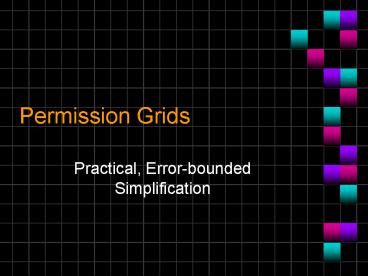Permission Grids - PowerPoint PPT Presentation
1 / 28
Title:
Permission Grids
Description:
... grid in detail. Results. Current and future work. Permission Grids - Steve ... Permission Grids - Steve Zelinka. Algorithm Overview. Choose grid resolution ... – PowerPoint PPT presentation
Number of Views:68
Avg rating:3.0/5.0
Title: Permission Grids
1
Permission Grids
- Practical, Error-bounded Simplification
2
In a Nutshell
3
Overview
- What good are error bounds?
- Desirable properties of error-bounded
simplification - Previous approaches
- Permission grid in detail
- Results
- Current and future work
4
Why Error Bounds?
- Surface reconstruction accuracy
- Progressive refinement
- Finite element methods
- View dependent refinement
- Medical applications
- Collision detection
5
Measuring Error
- D(p, S) minimum distance to S
- D(S1, S2) max over p in S1 d(p, S2)
- One-sided Hausdorff distance S1 g S2
- max( D(S1, S2), D(S2, S1) )
- Two-sided Hausdorffdistance
D(T, C)
D(C, T)
6
Desirable Properties
- No assumptions about input mesh
- Allow topological changes
- Level of detail control
- Efficient
7
Previous Approaches
- Vertex clustering
- Rossignac and Borrel 93
- Low and Tan 97
- Lindstrom 00
- Drawbacks
- Hard to control
- Low-quality LOD
- Error bound questionable
8
Previous Approaches
- Planar Approximations
- Kalvin and Taylor 96
- Drawbacks
- No topology change
- Manifold only ?
- Slow
- High face counts
9
Previous Approaches
- Local re-projection
- Ciampalini, et al, 97
- Klein, et al, 96
- Kobbelt, et al, 98
- Ronfard and Rossignac, 96
- Drawbacks
- Manifold only
- No topology change
- Input-sensitive
10
Previous Approaches
- Local re-mapping
- Bajaj and Schikore 96
- Cohen, et al, 96
- Drawbacks
- Manifold only
- No topology change
- Slow
11
Previous Approaches
- Tolerance Volumes
- Cohen, et al, 96
- Input-sensitive
- Manifold only
- No topology change
- Guéziec, 96
- No topology change
- Very complex
- Slow
12
Permission Grids
- Another Tolerance Volume
- Shape is union of a-prisms
- Satisfies all desired properties
13
Algorithm Overview
- Choose grid resolution
- Voxelize a-prisms of the input mesh
- While there are candidate simplification
operations - Test the triangles generated by the next
operation - If any fail, reject the operation
- Otherwise, perform it
14
Resolution and r
- Effective e dependent on grid resolution
- Define precision r e / voxel length
- E.g., r 4
15
Effect of Changing r
1.25
2
4
8
16
Voxelizing a-prisms
- Anti-aliased volume graphics
- Dachille and Kaufman, 00
17
Testing Triangles
- 3D generalization of 2D rasterization
- Kaufman and Shimony 86
- Project into 2D
- Rasterize
- Reproject into 3D
18
Advantages
- Simple
- Examine only one triangle at a time
- No assumptions on input
- Parallelizable
- Topological change possible
- Output-sensitive
- Can incorporate additional sources of information
into simplification
19
Advantages
- Incorporate additional sources of information
into simplification
20
Level of Detail Control
- Expand grid by one voxel when stuck
- Increases e by the voxel length
21
Disadvantages
FromOriginal
- Conservative grid expansion
- Limit on e
- Only one-sided error bound
- Boundaries need special treatment
Expanded4 times
22
Boundaries
- Use supplementary grid with voxelized boundary
edges
23
Results
- Venus at 0.5
Original Permission Grid
QSlim
Simplification Envelopes
24
Results
- Venus at 1
QSlim
Original
Permission Grid
SimplificationEnvelopes
25
Results
- Bottom of Stanford Bunny at 1
Original
Permission Grid
QSlim
Simplification Envelopes
26
Results
- Buddha at 1
Original Permission Grid
QSlim
27
Results Summary
- Generally an order of magnitude faster than
Simplification Envelopes - Overhead of approx 2-5x QSlim
- More simplification for given e
- Better max/average errors for given e
28
Future Directions
- Compression
- Adaptively-sampled distance fields
- Spatial data structure, allows distance to mesh
reconstruction anywhere - Compact
- No modification required to change e
- Can optimize placement instead of reject

